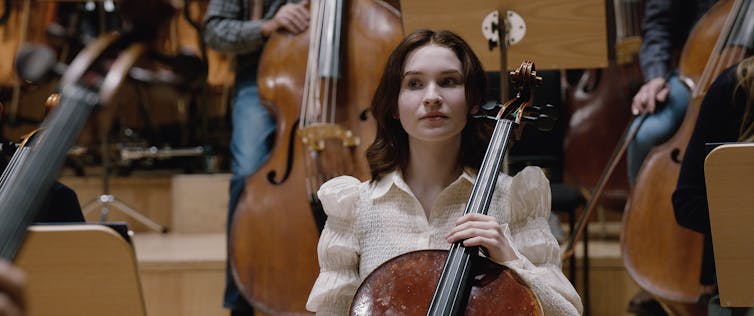¬†is a¬†Professor of Musicology at¬†Őż≤Ļ≤‘ĽŚŐż¬†is an Instructor of Music at¬†.
Musicians and music scholars are excited to see į’√°įý earn Oscar nominations in 2023. The psychological thriller is set in the rarefied world of classical music, starring Cate Blanchett as a brilliant, ruthless conductor of the real and renowned .
Music, ephemeral in its power over our emotions, is a notoriously demanding discipline, so this film presents exciting possibilities for an exploration of the dark sides of the ‚Äú.‚ÄĚ The film also shines a spotlight on the challenges of working in the ultraconservative world of classical music. It gives musicologists a chance to discuss not only the portrayal of music, but also some of the complex social issues present in classical music spheres, such as misogyny, racism and homophobia.
Gustav Mahler’s Symphony No. 5
į’√°įý‚Äės story revolves around . As Blanchett conducts the opening measures of the dramatic score, she swings her arms wide and punches the air aggressively. Mahler‚Äôs Fifth is a heart wrenchingly beautiful rumination on death, so the brooding music complements į’√°įý‚Äôs darkness and helps to foreshadow her downfall. Director Todd Field as his own ‚Äúgateway drug into a lot of classical music.‚ÄĚ In this film, he says, the symphony is ‚Äúhaunting her, coming for her.‚ÄĚ
Indeed, the ways that ‚ÄĒ waking her in the night, alarming her when out for a run ‚ÄĒ contribute significantly to the spooky, gothic story. And how else would a musician be haunted, if not through her ears?
Women breaking barriers in classical music
Although the fictional Lydia į’√°įý leads the Berlin Philharmonic, in reality, that orchestra has only ever had male conductors ‚ÄĒ though they were ahead of the , which did not admit women even as orchestra members until 1997. Indeed, orchestral conductors are disproportionately male and straight, and .

A superb conductor like navigating misogyny and homophobia while rising through world.
Alsop, who is mentioned in the film, and , leads through innovative approaches. Alsop is currently chief conductor of the Vienna Radio Symphony Orchestra and regular guest conductor with major orchestras.
Other female and queer musicians are passed up for positions, and otherwise abused in the orchestral world. Orchestras implemented specifically to combat sexist bias in assessing talent. Similarly, , has developed strategies to dismantle systemic barriers for Black, Indigenous and other racialized musicians.
Female conductors urged to project power
Orchestras and audiences tend to construct an ideal of a conductor as someone with a powerful aura, so female conductors are often urged to project a strong, imperious persona. reports that young female conductors who choose a gentler physicality risk criticism for their ‚Äúweak‚ÄĚ presence and lack of power to command a full, rich sound.
depict female conductors in contorted poses. We see their hair flying as if blown by the sounds they create, and bodies struggling to contain the power they exude. Depictions of Lydia į’√°įý are no different, as we see in į’√°įý‚Äôs .
‚Äú,‚ÄĚ Alsop told the New York Times. But, she noted, when women do that, they‚Äôre interpreted as being pushy.
A missed opportunity to depict nuance
The filmmaker‚Äôs presentation of Lydia į’√°įý, a white lesbian, is as a white masculine-style authority. It makes her out to be a mere copy of her straight male colleagues. But the reality for the few queer conductors working in the field is thankfully much more interesting.
For example, cellist and composer explores the reality of working with orchestras as an Indigenous and queer Canadian in their 2015 work, . By dispensing with a conductor and elevating a drum circle and cello soloist to lead performance of this work, Derksen asks musicians and orchestras to let go of conventional notions of authority. Derksen’s music re-centres that authority toward a queer and Indigenous perspective.
Coda: the epilogue
Editor‚Äôs Note: This section contains spoilers which reveal plot details of the movie, 'į’√°įý‚Äô
The final segment of į’√°įý works like a coda ‚ÄĒ an additional musical section that comes after the musical resolution, like an epilogue ‚ÄĒ to this cautionary tale. The story began with į’√°įý telling a hushed, respectful audience that music consists of time, controlled by the conductor. Its conclusion sees her alone in her dreary childhood home, watching her mentor
This is the lesson that į’√°įý has failed to learn.
The coda ends with į’√°įý banished from the elite western orchestra circuit. Instead, she is working in an unnamed country in the Global South. Here, she is depicted as the bearer of the European classical musical tradition. Her players and audience are depicted as obedient, but indifferent.
As the scene closes, it is revealed that she is actually conducting video game music; this is a dreadful fate for an elite musician. This scene ruefully acknowledges that are nowadays where western orchestral music resides, for audiences and working musicians alike.
į’√°įý‚Äôs whiteness, within a neocolonial context, allows her to cling to the authority she has been stripped of elsewhere. It is not clear, though, that she is capable of truly grappling with the or whether her arrogance will blind her even to this final lesson.![]()
This article is republished from under a Creative Commons license. Read the .

